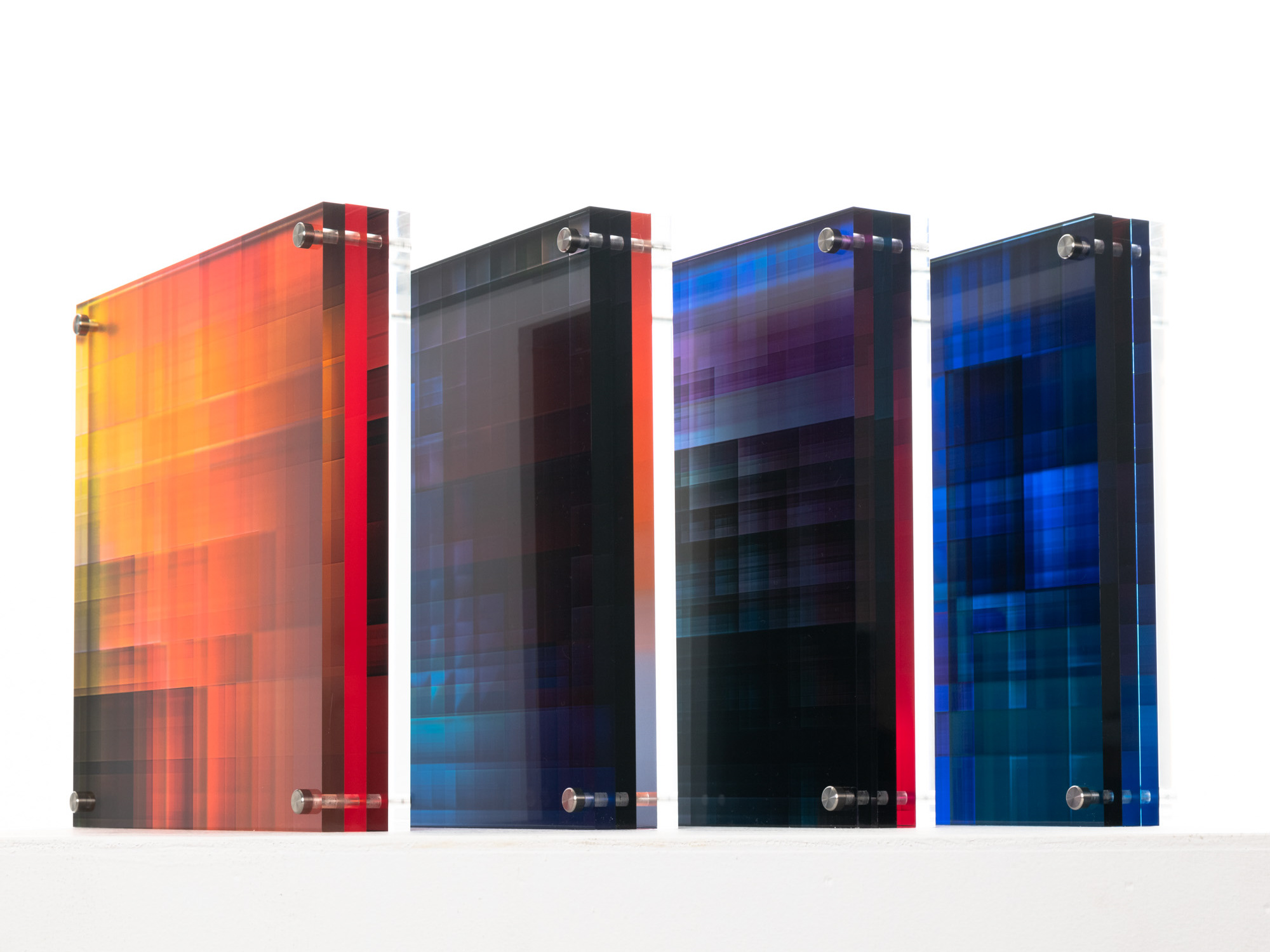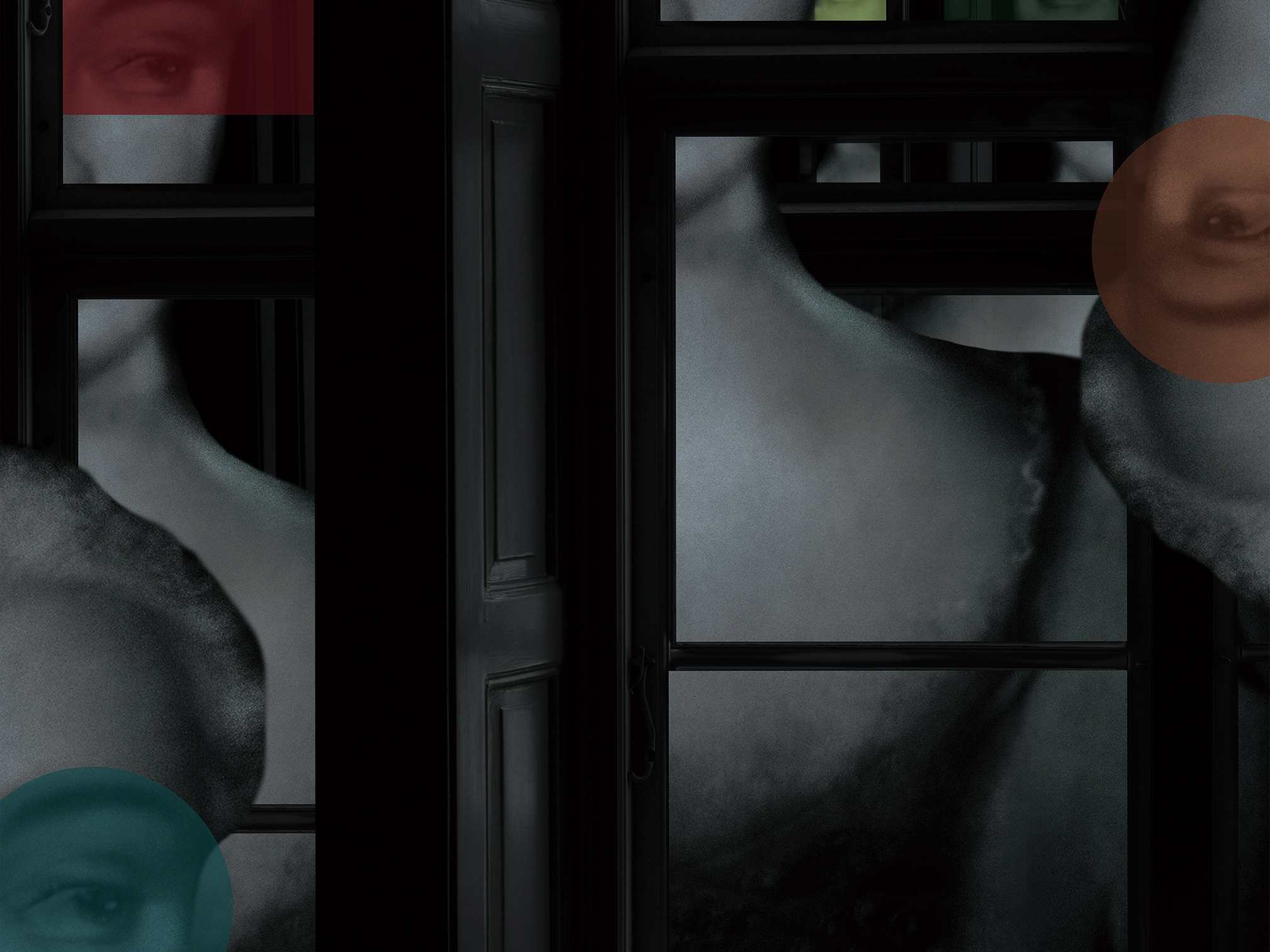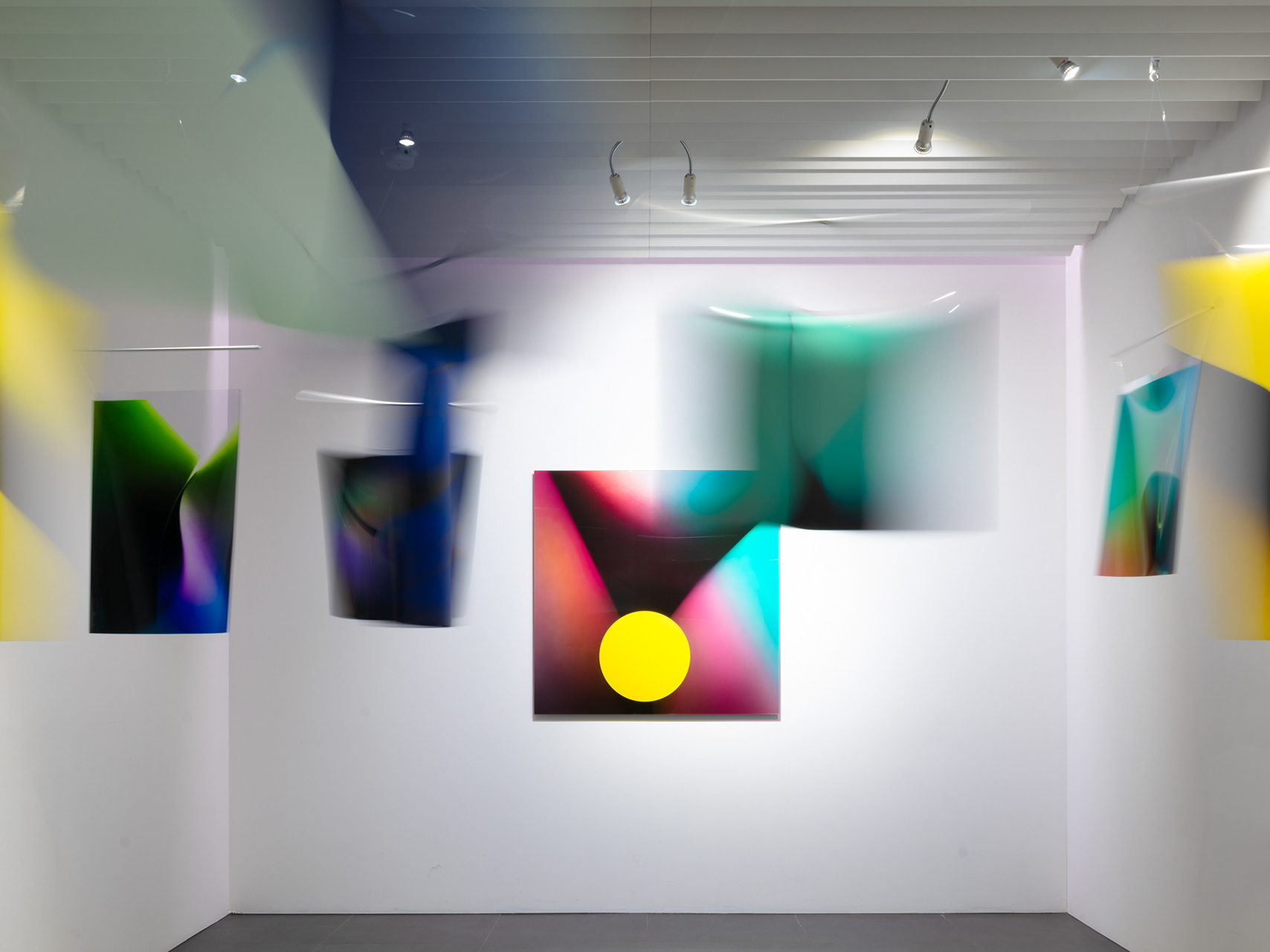Four season’s (2022) is a series of three-dimensional work that illuminates eroticism in Japan, referencing shunga "Four Seasons Picture Scrolls" by ukiyo-e artist Tsukioka Settei (1710-1787). By applying mosaics, patches, and painting the images black, not only does it restrict the viewers from discerning the whole picture, the work deconstructs and was reconstructed in a form of sculptures aiming to empower creativity whilst contemplating the presence and influence of Japan’s censorship that was imposed at the time.
Since early-Meiji era, the aforementioned technique was born and vastly developed in accordance to the government’s law prohibiting the depiction of genitals.
These acts were generally perceived negatively, however, during MUGA’s adolescence where he used to project his own fantasised ideals over the mosaics — they in turn became positive expressions that truly inspired.
Magnified, intricately crafted and composed by MUGA, the semi-transparent acrylic panels are installed lavishly with multi-degrees of complexity creating layers of vigorous colours together with vague patterns for the viewers to decipher.
MUGA refers this to a concept of “affirmation of fabricated facts” that he himself developed over the course of years, as a company director who has to practise capitalism, the work is also an antithesis to the pursuit of correctness, in a modern society prioritising lucidity, and to the artist himself who he believes is exceedingly influenced by Western ideologies.
Four seasonsは題材に浮世絵師、月岡雪鼎(1710〜1787)の春画 「四季画巻」にモザイク処理やパッチを施す事で日本におけるエロティシズムの点と点を繋げた作品です。それは同時に、日本における検閲・規制を可視化し、それをクリエイティビティで超えようとする日本の特異な性質を浮彫りにしています。
鑑賞者への情報を制限する行為である画像処理モザイクや黑塗りは、明治初期から現在に至るまでの性器の描写を禁止する検閲によって生まれた技術です。 本来ネガティヴなこれら行為は、MUGAの思春期の経験(黑塗りやモザイクに自ら理想を投影していた)により、人の創造性を引き出すポジティブな表現として使用されます。
MUGAによって編集、巨大化された半透明のアクリル板は複雑に設置される事で色の重なりを生み出し鑑賞者に理解する事を拒みます。 それは会社経営者、つまり資本主義を裏側から見る立場の MUGA が 導き出した"虚構の肯定" という一つの概念であり、正しさの追求や解像度を上げる情報社会、そして⻄洋概念に染まる自身へのアンチテーゼでもあるのです。
Tsukioka Settei (1710-1787)
Four Seasons

Spring
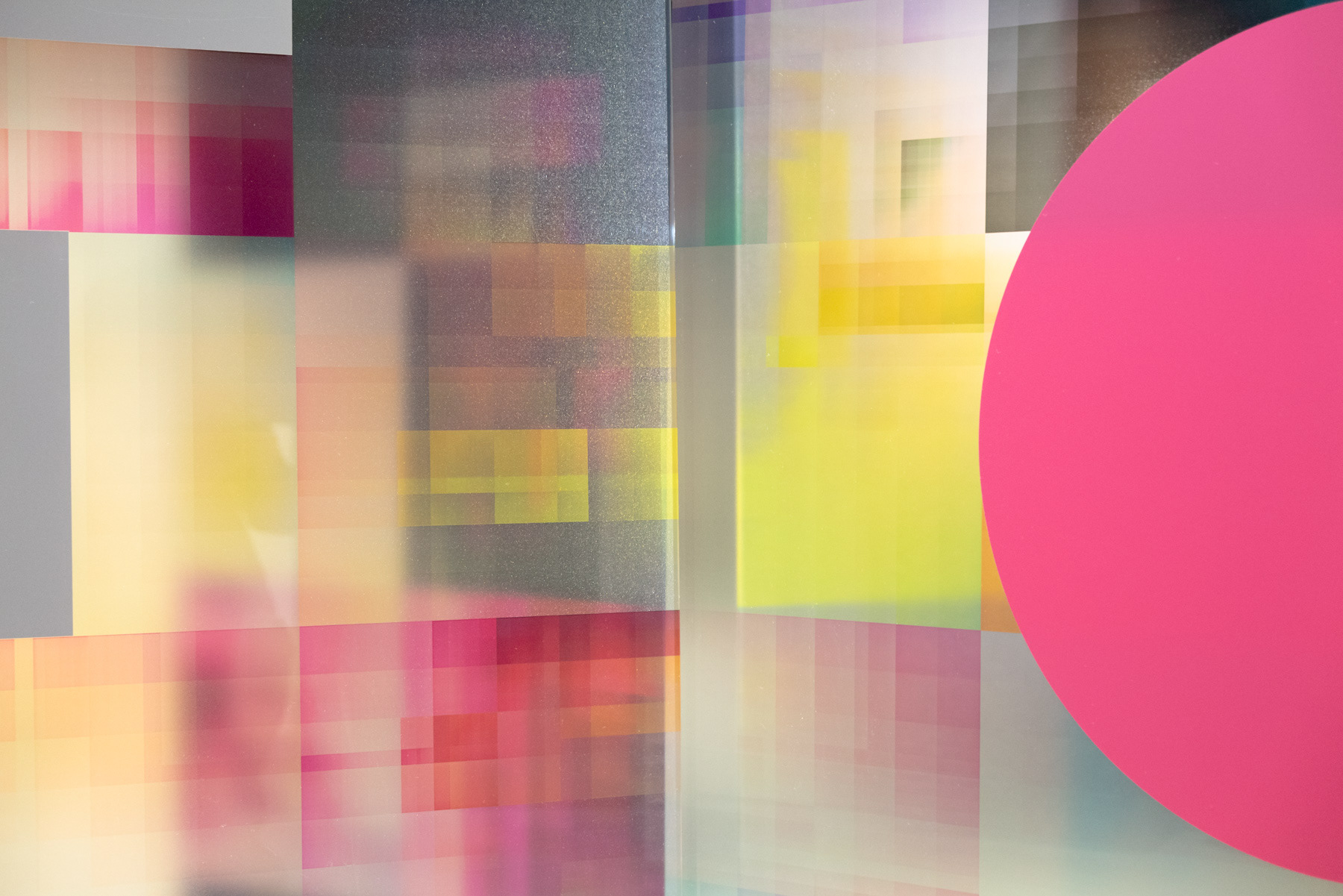


Summer



Autumn

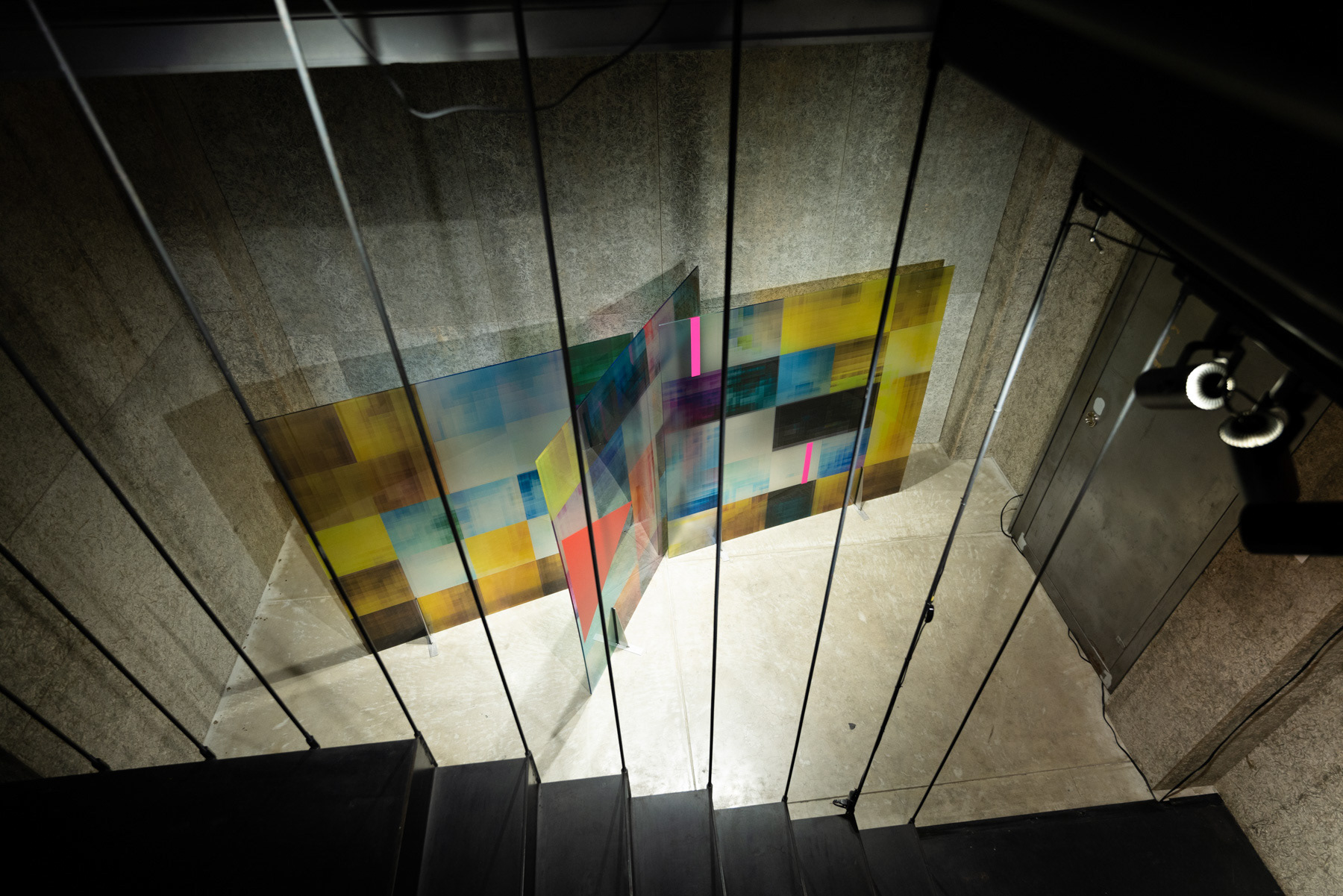
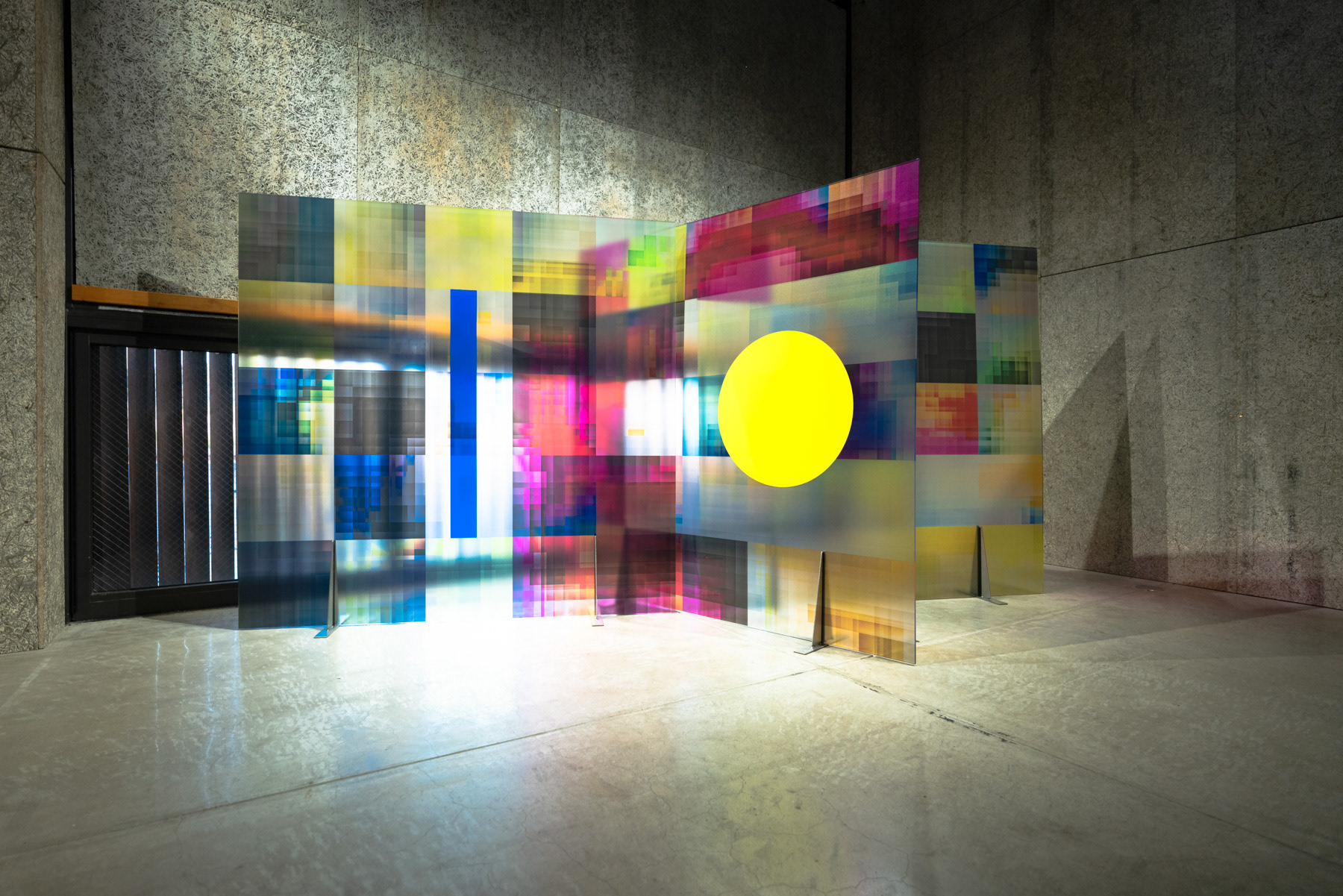
Winter
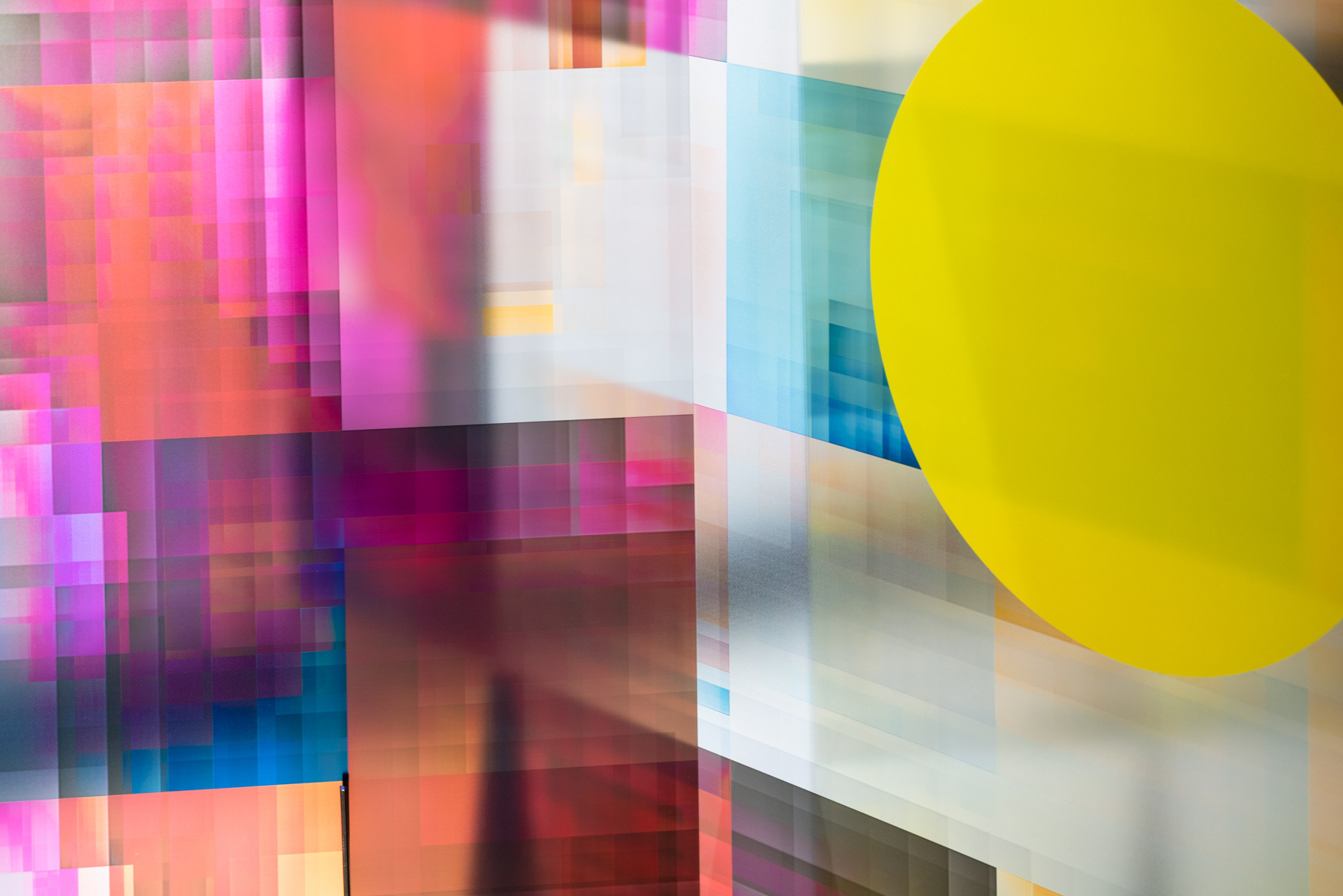
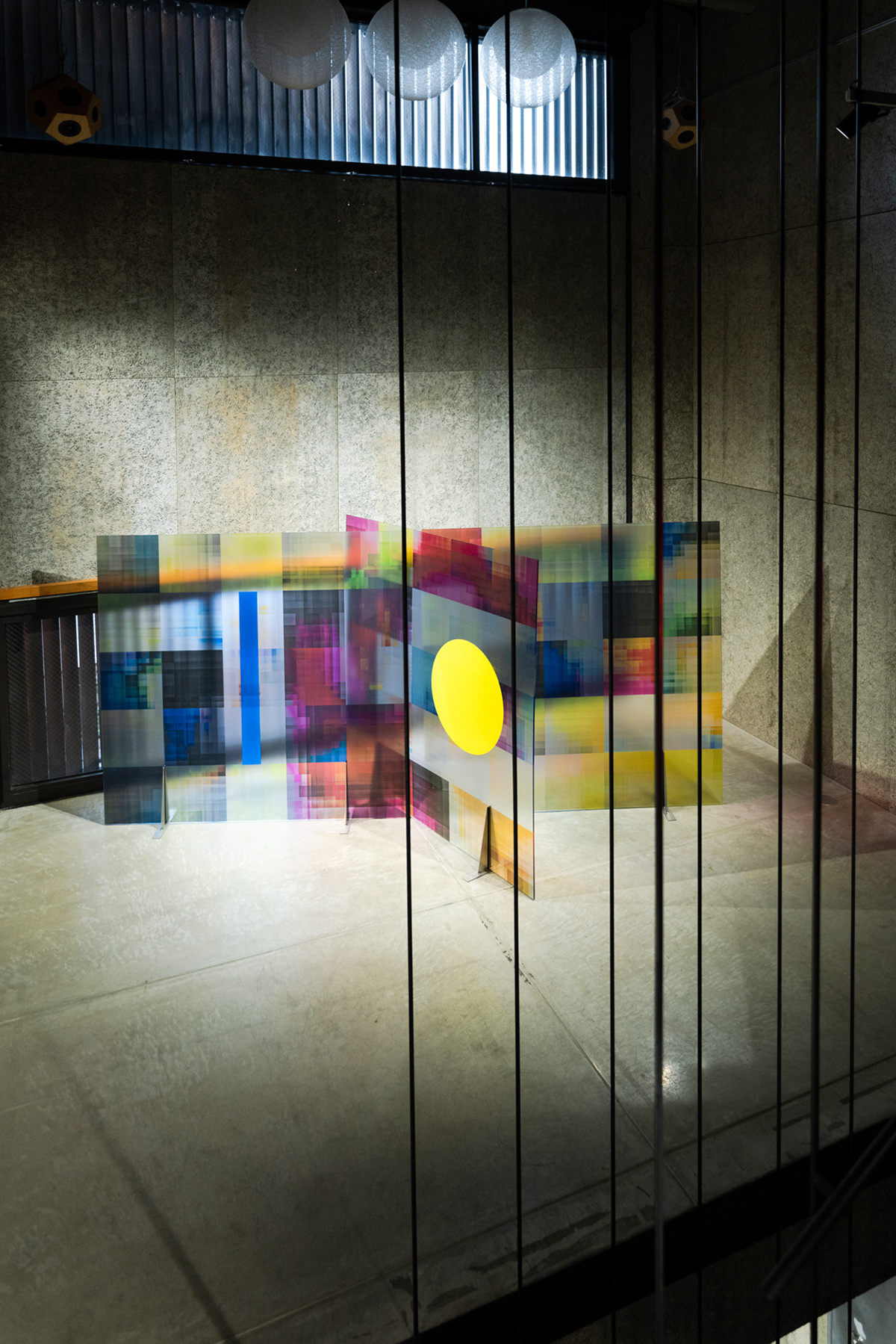
Four season’s [Spring , Summer , Autumn , Winer] / Sculpture / UV-ink & PVC-sticker on plexiglass [made of 2 layers of 2 images] , Stainless steel / H150 cm × Variable
d●●●p▲▲I■■■ / COCO gallery Kyoto / 2022
The Aestheticization of Self-Censorship —— MUGA “Four Season’s”
Text: FUJIMOTO Rui
(the art critic)
MUGA is a Japanese visual artist with an unusual background: former professional snowboarder, then antique dealer, currently a business owner. His creative medium involves often photography or an open-ended symbol for reality, centering “concealing / regulations” on his source of imagination.
This latest work series by the artist, “Four Season’s” is a three-dimensional work consisting of three intersecting panels, each composed as 5x5 grid pattern. This mosaic element had been implemented onto many of his works since his early career as an artist. When you gaze at each of these squares, you will realize that they are tiny single mosaics. According to MUGA, the panels were initially created from a single image, the resolution was reduced to pixels, and the image was then reconstructed into the grid pattern that we see now. In addition, the colour saturation of each square has been broken up.
For this series, he cited “Four Seasons Scroll(《四季図巻》)” by the ukiyo-e artist Tsukioka Settei(月岡雪鼎1726-1787), which is now privately owned by an overseas collector. This original material of the work is shunga / pornographic art, but its colours and contours there were re-constructed upon his practice, so the image was destroyed to the faintest trace.
The attempt to destroy the image itself through digital manipulation reminds us of the series of “jpegs” by the photographer Thomas Ruff. In the post-internet world, incidents, accidents or otherwise, are no longer viewed through the medium of the screen. Ruff is a photographer who was aware of this situation. The photographic work series “jpegs” is an output of low-resolution data in its original form, it captures the kind of “rough” image that appears in a usual image search on the internet.
Each work of “Four Season’s” is covered with a ●▲■ cutting sheet on the panel. The purpose is to conceal specific parts of the image, echoing the erotic photography that is the material for the work. In other words, it reflects the ‘unviewable or not-to-be-seen’, that he imbued into his work, also as a form of self-censorship.
To address this manipulation of censorship, the work of Jenny Holzer can be used as a case study. Born in the United States in 1950, Holzer creates works with the motif of ‘language’, and many of these works have been exhibited in public spaces. However, what I would like to feature here is Holzer’s series of works based on classified documents of the U.S. government. In these works, the emphasis is not on sharing discourse in the public sphere, but on how information is obscured/rewritten. What is interesting here is the artist's own aesthetical touch of such manipulations. In other words, those series by Holzer have become depicted as works of painting. How the artist's hand repaints the public object of censorship (as can be seen from the title of Holzer's work: “Renewing”), is what could be described as an ‘aestheticization of censorship’. In this regard, MUGA's work seems to have more affinity with Holzer's work than with Ruff's.
Still, the main difference is that the motif of MUGA's work is pornography. It is not, as in the case of official documents, based on a reason not to be shown to others, but on an ambiguous but certainly existing common understanding that it should not be shown to others. Hence, the censorial touch in “Four Season’s” is accompanied by a subjective judgement of what should not be shown. It is, in other words, an ‘aestheticization of self-censorship’.
The complex mosaic that has been composed in this way is an image that has been so disrupted that it eclipses our ability to recognize it. However, the viewer of the image can still try to connect the contours of the image to see if there is anything identifiable about it.
There should be a desire to see and reveal something. This desire wavers like a magnet suspended in mid-air, trying to find a connection between the image and our own known realms. But it also explained our inability to process the images presented to us based on such little information. When I look at MUGA’s work, I understand empirically that I myself am such an imperfect machine.
“Four Season’s” was first exhibited at his solo show, “d●●● p▲▲ i■■■■”, held as part of KYOTOGRAPHIE's satellite event “KG+” for one month from April 8, 2022, at COCOTO Gallery in Nakagyo-ku, Kyoto.
自己検閲の美学化——MUGA「d●●● p▲▲ i■■■■」について
文=藤本流位(現代美術論)
2022年4月8日から一ヶ月のあいだKYOTOGRAPHIEのサテライトイベント「KG+」の一環として、京都市中京区のギャラリーCOCOTOにてアーティストのMUGAによる展覧会「d●●● p▲▲ i■■■■」が開催された。本展覧会で発表された作品「Four season’s」はMUGAがこれまでに継続して使用するモザイクが大きく展開されたシリーズであり、会場ではギャラリーの階段を登るごとに四季をモチーフにした4つの作品を見ることができる。
「Four season’s」は3枚のパネルを交差して組み上げられた立体作品であり、それぞれのパネルは5×5のマス目状に構成されている。その一つ一つのマス目に注目すると、それが細かいモザイクになっていることがわかる。MUGAによると、このパネルはもともと一つのイメージを素材にしてつくられたものであり、解像度をピクセルになるまで下げ、それをマス目状に再構成したものだという。さらには、マス目ごとにその彩度もバラバラにされている。素材になっているのはポルノグラフィということらしいが、色彩も輪郭もバラバラにされ、イメージはその痕跡が微かにしか感じ取ることができないまでに破壊されている。
デジタル処理によってイメージそのものを破壊するという試みからは、写真家のトーマス・ルフ(Thomas Ruff)による「jpegs」のシリーズを想起することができるだろう。インターネット以後の世界では、事件や事故、あるいはそれ以外の出来事ももはやスクリーンを媒介にして見るものになっている。ルフはこのような状況に自覚的な写真家であった。「jpegs」は低解像度のデータをそのまま出力した写真作品であり、それは、画像検索で引っかかるような「粗い」イメージを写し出している。
MUGAの作品もまた「インターネット以後の写真」ということが打ち出されている。今回の作品を制作するにあたり、MUGAが引用元とする浮世絵画家の月岡雪鼎の「四季画巻」もまた海外の個人が所有する作品のため、現在のわたしたちはそれをデータでしか受け取ることができない。
しかし、作品はそれだけで成立しているわけではない。「Four season’s」のパネルにはそれぞれに●▲■のカッティングシートが貼られている。これには素材となったポルノグラフィに対応するかたちでイメージの特定の部分を隠すという役割がある。つまり、それは制作者による「ここは見せてはいけない」という配慮、一種の自己検閲なのだ。
この検閲という操作について考えるため、ジェニー・ホルツァー(Jenny Holzer)の作品を事例として挙げる。1950年にアメリカで生まれたホルツァーは「言葉」をモチーフにした作品を制作し、その作品の多くは公共空間にて発表されている。しかし、ここで取り扱いたいのは、そのようなホルツァーの作品のなかでもアメリカ政府の機密文書をモチーフにした作品のシリーズである。それらの作品では、パブリックな場で言葉を共有するのではなく、いかにして情報が隠蔽/書き換えられるのかに焦点が当てられている。ここで興味深いのは、そのような操作のなかにある作家自身の美学的な手つきである。すなわち、ホルツァーによるそれらのシリーズは、ペインティング作品として描かれたものになっているということである。検閲というパブリックなものをいかにアーティストの手によって塗り替えるのか(ホルツァーの作品タイトル「Renewing(書き換える)」からもそのような意図が窺える)、そこにあるのは「検閲の美学化」とでも言えるようなものだ。
この点において、MUGAの作品はルフよりも、むしろホルツァーの作品と親和性が高いように感じられる。つまり、MUGAの作品もまた、イメージをいかにして見せないようにするのか、隠すかということに重心が置かれている。ここでは、そのような作家による操作そのものを芸術作品として見るべきだろう。
しかしながら、MUGAの作品はホルツァーとも異なっている。それは先述したように、ポルノグラフィがモチーフであるというところが大きい。それは、公的な文書のように理由があって他者に見せてはいけないというわけではなく、他者に見せてはいけないという曖昧だけれども確かに存在する共通認識が前提になっている。それゆえに「Four season’s」における検閲的な手つきは、何を見せるべきではないのかという主観的な判断が伴ったものなのだ。それはつまり「自己検閲の美学化」である。
そのようにして構成された複雑なモザイクは、わたしたちの認知できる範囲を飛び越えるまでに破壊されたイメージだ。しかし、そのイメージを見るものはそれでも何か認知することができないかとそのイメージの輪郭をつなごうとするのではないだろうか。
そこにあるのは、何かを見たい、明らかにしたいという欲望である。その欲望は、まるで宙づりにされた磁石のように揺れ動きながら、イメージを何か自分の知っているものに接続しようとする。しかし、それは、わたしたちが提示されたイメージをただそれだけの情報として処理することができないということの説明でもある。MUGAの作品を見つめるとき、わたしは自分自身がそのような不完全な機械だということを経験的に理解するのだ。


